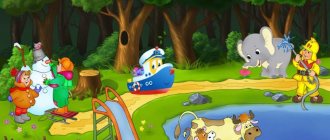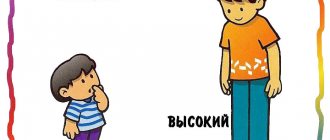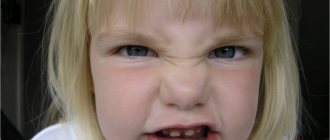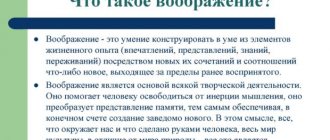Diagnostics of mathematical development of preschool children
Know how to play checkers and chess. Using tasks to find the missing figure, develop logical thinking, resourcefulness, and ingenuity. Be able to explain a familiar route. With the help of the teacher, familiarize yourself with the area plan, diagram map, and scale.
Be aware of time, consciously use units of time (hour, minute, day, week, year). Find your bearings by the clock.
Indicators:
know numbers and signs, be able to use them when solving arithmetic problems;
be able to justify the choice of arithmetic operation;
know some rules of computing; be able to measure with a meter, liter, ruler; compare polygons, explain their features; know the basic rules for pedestrian traffic on the street, the route from home to kindergarten, store, school; be able to draw a plan for a group room; use knowledge in independent activities (game, everyday, visual, constructive); navigate by the clock using an alarm clock.
Beginning of the form
3.Children’s mathematical readiness for school.
Mathematics is one of the cultural spheres presented in the program, interaction with which contributes to the child’s organic entry into the modern world.
Mathematical readiness for learning at school is an indicator of mastering the mathematical content of the surrounding reality, which is aimed, first of all, at developing the cognitive and creative abilities of children, the ability to generalize, compare, identify and establish patterns, connections and relationships, solve problems, put forward them, and anticipate the result and the progress of solving a creative problem. In a more specific interpretation, mathematical readiness is an indicator of the ability to perform arithmetic operations with numbers, mastery of sign systems, basic modeling, independence in solving creative problems and evaluating results.
The content of mathematical education for preschoolers is dominated by logical tasks leading to the knowledge of patterns and simple algorithms.
Mastering mathematical content is aimed, first of all, at developing children’s cognitive and creative abilities, such as the ability to generalize, compare, identify and establish patterns, connections and relationships, solve problems, put forward them, anticipate the result and course of solving a creative problem.
Educational and game tasks are presented as educational: children master the skills of finding a pair, grouping objects, searching for something missing, determining the direction of movement, and so on.
Only schoolchildren who are properly prepared in preschool age can quickly learn to make correct conclusions, master the basic rules of logical inference, and fully “absorb” information related to mathematical logic - a science that contains a concentrated expression of the laws of deductive thinking.
Approaches to assessing the mathematical development of preschool children are varied depending on the conceptual ideas of the development program according to which the preschool educational institution operates and the process of development of mathematical concepts in children is directly constructed.To carry out diagnostics, informal test tasks are most often used, revealing the child’s current level of mastery of geometric figures, size parameters, skills to count and compare groups of objects by number, compose (practically) numbers from two smaller ones within 10, solve simple logical and arithmetic problems, etc. .d. With this approach to diagnostics, the mastery of the content specified in the program is mainly checked.
Other approaches to diagnosis are possible, for example, assessing mathematical development from the perspective of the child’s logical-mathematical experience, which includes mastering the actions (methods) of cognition and means of cognition.
Depending on the age of children, the following methods of cognition are subject to assessment: examination, comparison, equalization, counting, measurement with conventional standards, experimentation, transformation and reconstruction, modeling, etc. Among them, the most significant in terms of logical cognition can be identified: grouping and classification, ordering and seriation.
The means of cognition include sensory standards (color, shape), conventional measures (samples for comparison, comparison by size, mass, volume), images (ideas about spatial and temporal relationships, changes, numbers, quantities), models, speech.
Purpose of diagnosis
will consist of tracking achievements in a 5-6 year old child’s mastery of both means and methods of cognition.
Based on the results obtained, his logical-mathematical experience is determined, which is represented by a propensity (or lack thereof) for independent cognition, manifestation of activity in search and creative gaming activities, the ability to use mastered means and actions in order to independently discover the truth, simple connections and dependencies of groups of objects by properties (shape, size, mass, volume, location) and relations of correspondence and similarity, order (ordinal dependence), parts and the whole.
The process of interaction between an adult and a 5-6 year old child in a diagnostic situation will constitute the object of diagnosis.
The subject of diagnostics, aimed at identifying the logical and mathematical experience of a child, is the child’s training, his activity skills, interests and inclinations.
As a result, the child’s behavior in a cognitive situation will be revealed, the degree of manifestation of independence (starts to perform; asks, waits for help; doubts, says that he cannot cope) and specific skills to operate with numbers, simple schematic images and models, combine and decode.
An indispensable condition for choosing or developing diagnostics for the mathematical development of children is its compliance with the educational program being implemented.
The provisions set out in this paragraph about the purpose of diagnosing the mathematical development of children (identifying logical-mathematical experience), its focus on assessing the level of cognitive and personal development, activity and independence of children, the ability to express in speech methods of practical activity, connections and dependencies gives grounds for classifying it to the program “Childhood” (section “First steps in mathematics”).
Such an approach to diagnosing the mathematical development of preschool children involves, to a greater extent, identifying the levels of mental development achieved, including in mastering logical and mathematical content, rather than specific skills in the practical operation of figures, quantities, and numbers.
In our opinion, this position does not conflict with the conceptual ideas of the section “First steps in mathematics” of the “Childhood” program, which is designed based on the principles of the theory of developmental learning and modern pedagogical technologies for the development and training of preschool children.
Using the example of diagnostics of mathematical development of children 5-6 years old, developed by Z.A. Mikhailova and I.N. Cheplashkina, we will consider the basic requirements for organizing the diagnostic procedure.
The form of organizing a diagnostic examination is problem-game situations, which include cognitive tasks.
The initial (initial diagnosis) is carried out at the beginning of the school year (at the end of September) and consists of three situations: “Who is not drawn in the picture?”, “Enter the hut”, “Restore the ladder”.
Diagnostic situation “Who is not drawn in the picture?”
The child is presented with a logical task with an incomplete set of pictures. Instead of one missing picture, as is usually the case in such problems, there are three. An example is the second row, where what is said in the situation is drawn: Christopher Robin drew his friends, Eeyore, Winnie the Pooh and Piglet, in different ways: cheerful - with slitted eyes, surprised - with round eyes, scared - with square eyes. The friends looked at the artist’s drawings and took the best ones.
Instructions: “Look at the picture and tell me who took the pictures and which ones?
(Children use answer options.) Can you prove who exactly took these drawings?”
During the decision, it is important to understand and remember: who is drawn (donkey, bear and pig), how (with slits, round and square eyes). The combination of features is unknown: the name of the animal, its inherent eye shape, location (three features). To practically search for answers, you need to cut the second (drawn on the right) picture, arranging the resulting squares in the same order.
To search for portraits that have already been taken, and those who took them, you should “uncover” the pattern that each row and column contains all three features: different animals, with three eye patterns, with different locations in space.
When solving this problem, the child practically chooses portraits that have already been taken. In the top row is a portrait of a bear cub, but with square eyes; in the third (bottom) row on the left - a bear cub with slitted eyes and on the right - a donkey with round eyes.
Diagnostic tasks:
identify children’s ability to compare and generalize based on signs of similarity and difference, independently “discover” for themselves the rules for constructing a logical problem (which figure to put where), reason, detect and correct errors.
Naturally, it is possible to complete the assigned diagnostic tasks only under the condition of friendly communication between an adult and a child, confirmation of both correct answers and doubts, avoiding direct prompts.
Diagnostic situation “Enter the hut”
The goal involves identifying the practical skills of children 5-6 years old in composing numbers from two smaller ones and in carrying out search actions.
On three huts located in a row, the numbers (6, 9, 7, respectively) indicate the number of gold coins. Traces lead to the huts. Only the one who opens the door can take the coins. To do this, you need to step on the left and right footprints together as many times as the number shows. (Mark with pencil.)
Teacher: “Which hut did you choose? What tracks will you step on? Check if the door will open? If you want, then enter other huts.”
Diagnostic situation “Let’s restore the ladder”
The goal is to identify skills to detect violations (errors) in the order of objects in height, restore rows, and explain errors based on establishing the correspondence of objects in height and serial number.
The name of the situation “Restore the ladder” indicates the game orientation and the implementation of a number of actions.
The ladder of Cuisenaire’s counting sticks is made with the passage of the “6” stick on the ascent and the “5”, “4”, “2” sticks on the descent. To carry out diagnostics, you can use a drawing, but it is advisable to make a ladder on a plane and put the missing sticks, among which there should be “extra” ones.
Instructions. Hungry, curious mice smelled the cheese, but couldn’t climb the steps to get it. Name the numbers of the steps that the skinny mouse is going to climb. Which step in order is missing in his ladder? Can you fix the ladder? Fix it!
Name the numbers of the steps that the fat mouse is going to climb. What steps in order are missing in his ladder? Name it. Help him too! Now he can enjoy cheese? Is it comfortable to walk up the stairs now?
So, three situations that can be presented to a child of the sixth year of life will help the teacher to navigate how children relate to such situations, whether they are interested in them, what level of mental activity they show in this case, what their skills are to compare and use the results when solving cognitive problems. tasks, understand simple patterns of alternation, sequence, establish the relationship between numbers and numbers, compose numbers from two smaller ones, establish the order of quantities and numbers.
At the end of the school year, diagnostics are carried out again, also represented by three game situations. Children's age is 5 years 8 months—6 years.
Diagnostic situation “Correct the mistakes and name the next move”
The goal is to identify children’s abilities to follow the rules of the sequence of moves, offer options for correcting mistakes, reason, and mentally justify the course of their actions.
The situation is being organized without practical action. The child watches the adult’s progress, comments on his own move, and corrects mistakes.
Instructions. Imagine that you and I are playing dominoes. Some of us made mistakes. Find them and fix them. The first move was mine (left). As mistakes are discovered, the child is asked the question: “Which of us made mistakes? How can I fix them using additional chips?”
Diagnostic situation “Which days are missed?”
The goal is to identify children’s ideas about the sequence of days of the week, the ability to justify the order of the days of the week, and to restore missed days (in game conditions).
Instructions. Take a look at this calendar. This is four weeks. Let's determine what the children do on the first day of the week, Monday (music class), Tuesday (mathematics) on the second, etc. Look at the second week and tell me which days are missing. Give their serial numbers. Third week. Consider this. If it is Friday (show), then which 2 days are missing? Fourth week. Is it a full week?
Diagnostic situation “Whose backpack is heavier?”
The goal is to identify children’s skills in using methods for determining mass, comparing objects, explaining their train of thought, and using the words: “heavier,” “lighter,” “weighs the same.”
Instructions: look at the backpacks with fruit. (Who is carrying them? Where are they going? What is in the backpacks?)
What are the scales for in the picture? What is the weight of one pear?
“Weigh” fruits on scales using apples instead of weights. Determine the heaviest backpack, the lightest one. (You can use a pencil.)
So, during the final (at the end of the school year) diagnostics, the teacher identifies children’s abilities to act and think consistently on different contents: when navigating in the game “Dominoes”, in the days of the week, in the process of correlating one quantity with another when estimating mass. These requirements correspond to the capabilities of 6-year-old children and the tasks of the “First steps in mathematics” section of the “Childhood” program.
What should be assessed at the end of the diagnosis?
The teacher evaluates the effectiveness of his teaching activities: how active the child is, how smart he is, whether he understands the task posed in the situation, whether he is involved in search activities, whether he is reasoning about the result obtained or a mistake made, whether he is going in the right direction, whether he supports the dialogue started by an adult, whether he is fluent. necessary actions (comparisons, generalizations, measurements, etc.).
When summing up the diagnostic results, one should take into account the results of everyday short-term observations of the child, his behavior in a new unknown game, in a creative or problematic situation.
It is advisable to analyze the results according to the following indicators:
mastery of practical actions (methods of cognition) of the properties and relationships of both individual objects and groups in shape, size, quantity, mass; based on the identification of spatial and temporal relationships (at the sensory, elementary logical levels);
mastery of the skills to identify connections, dependencies, compare, alternate, establish and change sequences, model, schematize;
mastering the ability to express in speech the essence of practical actions and predictable ones (“how I will do”): measurement, dividing the whole into parts, increasing and decreasing in size, numbers, etc.;
manifestation of initiative in logical and mathematical activities, elements of search, experimentation, creativity - both in specially organized situations and in life situations that arise spontaneously.
Based on taking into account these indicators, it is possible to characterize the child’s logical and mathematical experience.
The teacher should take a responsible approach to identified deficiencies in the development of children:
analyze the subject-game development environment;
to initiate the creative cognitive activity of individual children on the basis of personal participation in their activities, the creation of play communities, and the use of motivation that is meaningful to them;
induce in children a desire to tell their parents about their successes in the group, about joint actions with peers and the teacher; select games, gaming materials necessary for independent mastery of actions that are especially necessary in a given period (knowledge of the dependencies between numbers, quantities in the conditions of a serial series);
practice organizing and conducting leisure activities, children's games, projects, joint events with parents, which will help increase activity in general.








